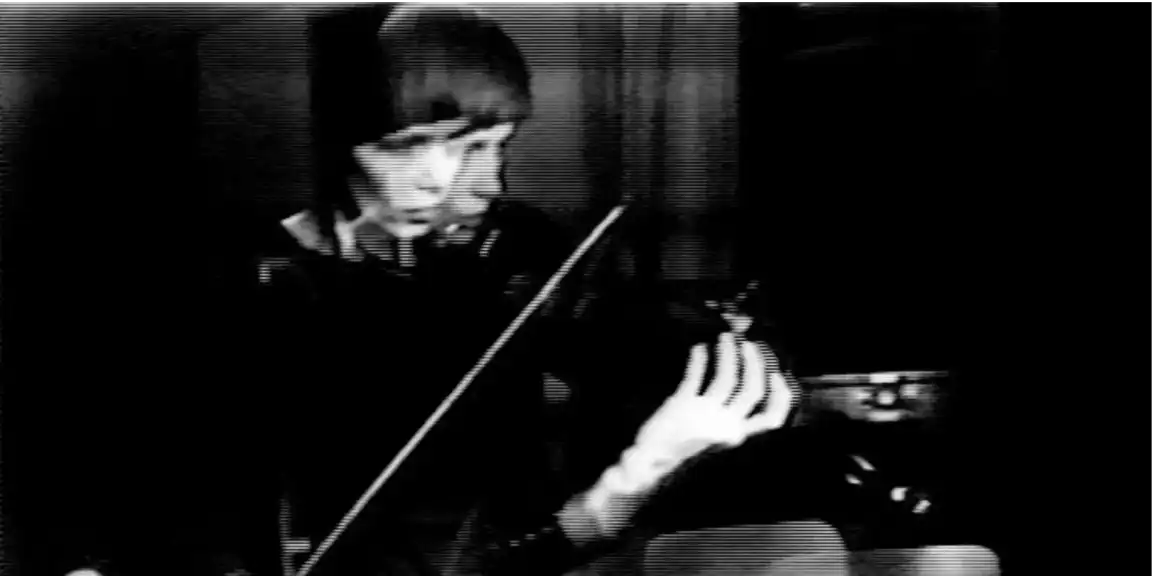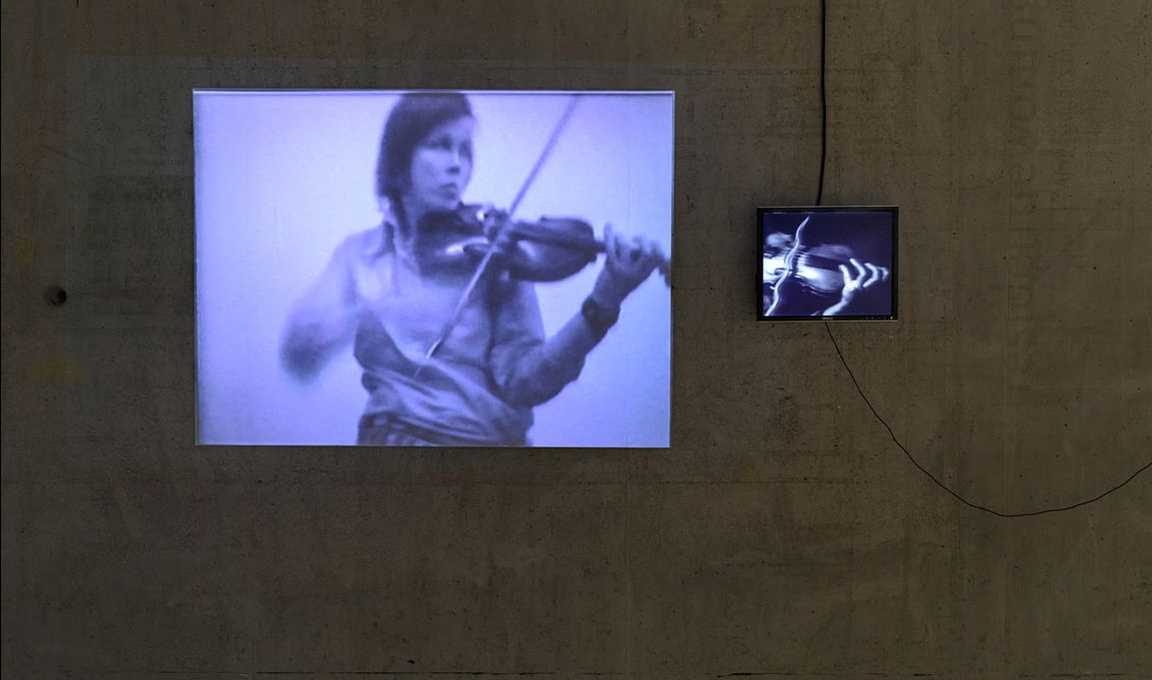
Preserving Steina's Violin Power
A multilayered exploration of art and performance
This multifaceted piece, which brings to life the intersection of technology and performance art, raises critical questions about the nature of art itself: How does the work of art change over time, and which elements can and should be preserved? What does it mean to preserve works of art that fundamentally address and embody the idea of change?
Violin Power is a seminal work by Steina Vasulka that epitomises the challenges inherent in preserving and presenting time-based media art. At its core, Violin Power is a 10-minute video, yet it embodies much more through a series of live performances that have evolved since the 1970s. As technology has advanced, so too has the potential for the work to transform, prompting discussions about its future at a roundtable held on July 1, 2021. This gathering brought together thirteen experts from various fields, including musicology, media conservation, and digital preservation, to address the complexities of preserving and presenting Steina Vasulka’s iconic work and explore how best to honour and present it.
Violin Power is an ongoing exploration that has greatly evolved since its inception between 1970 and 1978. As a live performance, the work has undergone significant transformations, integrating both analog and digital media tools, thus reflecting the artist's continuous experimentation with technology. At the heart of this inquiry lies the understanding that Violin Power represents a living work, one that cannot be distilled into a static form without losing its essence. The roundtable participants, including musicologists, conservators, curators, and artists, provided invaluable insights into the delicate balance between preserving the work's original characteristics and embracing its evolving nature.
Participants at the roundtable shared insights and suggestions that highlighted the significance of Steina’s original vision while considering contemporary technological contexts. For instance, Paul Klomp (Professor of Media Art, AKI Artez Enschede) emphasised that the Macintosh PowerbookPCs containing the original version of the Image/ine software might serve as a crucial reference point for presenting Violin Power. This idea opens up a dialogue about what it means to present an artwork at a particular moment in time, suggesting that the artist's choices about technology and software should be integral to the work’s exhibition.
A compelling thread throughout the discussions was the need for direct involvement from Steina herself. Musicologist Hannah Bosma asserted that Violin Power should only be performed by the artist, underscoring the unique relationship between the creator and the work. This perspective reinforces the notion that authentic representation stems from the artist’s intent, and as such, an artist interview would be essential for determining how the work should evolve in upcoming exhibitions.
Insights from the roundtable informed the presentation of Violin Power at the REBOOT: Pioneering Digital Art exhibition and shaped the conclusion of the research project. This process led to the creation of detailed documentation for five key performances of Violin Power, along with a comprehensive technical and performance timeline. Together, these elements provide a representative overview of how an artwork evolves over time, reflecting the artist's journey and creative development. LI-MA curator Sanneke Huisman proposed presenting this exhibition as a "funeral" for the artwork, a poetic yet poignant metaphor that highlights the passage of time and the transient nature of media art. This framing invites audiences to consider not just the work itself but also its cultural and temporal contexts.

Violin Power at REBOOT. Credit: Pieter Kers
Innovative Approaches to Documentation
Moreover, the roundtable participants explored innovative approaches to documenting and preserving the nuances of Steina’s performances. Suggestions ranged from creating descriptive scores to recording MIDI data, enabling future audiences to reconstruct specific manifestations of Violin Power. Such technical measures would enhance understanding of the work’s evolving nature and offer new pathways for interpretation, showcasing the dynamic interplay between technology and art.
The idea of reactivation emerged as a significant theme. Participants discussed the potential for collaborative performances, where other artists could reinterpret Violin Power, allowing for diverse outcomes while maintaining a connection to Steina’s original vision. Patricia Falcão (Time-based Media Conservator, Tate) emphasised the importance of viewing the exhibit as an “active archive”, suggesting that it could include various interpretations and interactions with the work, thus keeping the spirit of Violin Power alive and relevant.
Collaborative Archiving and Authenticity
As the discussions unfolded, the question of a distributed archive surfaced. Jean-Marie Dallet (Director, Visual Arts Department, University of Paris) proposed creating a collaborative online platform – akin to a wiki – that would allow for the sharing and linking of various documentation efforts related to Violin Power. This idea not only aims to broaden accessibility but also fosters community involvement in preserving Steina’s legacy.
Central to the dialogue was the tension between Violin Power as a "living work" and an "archival representation." Joey Heinen (Digital Preservation Manager, Los Angeles County Museum of Art) raised critical questions about authenticity: should the focus be on showcasing the performance, a representation of it, or a reinterpretation by another artist? These reflections are vital as they confront the underlying complexities of preserving time-based media art. The challenge lies in striking a balance between honouring the artist's intent and embracing the potential for new interpretations in a contemporary context.
Practical Preservation Strategies
To ensure the long-term preservation of Violin Power, LI-MA has established thorough protocols. These include backing up the original NTSC U-matic tape by transferring it to a different format, Analog Betacam SP, and implementing a digitisation process that converts the video into uncompressed digital files stored on LTO-5 tapes for enhanced durability. Additionally, multiple copies of the work have been produced, facilitating its accessibility in various contexts while adhering to recognised preservation standards.
Despite these efforts, the project remains ongoing, with much work still to be done. Future tasks include the detailed documentation of equipment lists, installation instructions, and performance scores, ideally in conversation with Steina. Furthermore, should engaging with the artist prove unfeasible, insights gathered from her collaborators could offer alternative perspectives, enriching the narrative surrounding thee work.

Credit: Reykjavík Art Museum
Steina: Playback
Insights from the Violin Power roundtable will inform future presentations of the work, reflecting the complex interplay of preservation, performance, and reinterpretation. As LI-MA director Gaby Wijers emphasised at the Vasulkas Reloaded Symposium in Brno (22–23 October, 2025), balancing technological adaptation with preservation of artistic intent is a central challenge in time-based media art.
Meanwhile, the Reykjavík Art Museum and the National Gallery of Iceland present Steina: Playback, the first major retrospective of Steina Vasulka’s work in Iceland, on view from 4 October 2025 to 11 January 2026. Spanning early documentary experiments to installations from the 2000s, the exhibition highlights her inventive, playful integration of video, music, and technology. For over five decades, Steina has profoundly influenced generations of artists worldwide, connecting music, video, performance, and installation through experimental electronic processing and what she calls “machine vision.”
LI-MA’s ties with Steina’s network run deep. In 1984, Steina organised a tour connecting colleagues and students from the USA, France, Germany, and the Czech Republic, including her former student Sigrun Hardar. The tour concluded at Listefan Arnesigna, now directed by Kristin Scheving, where works by Finbogi Petursson – who also studied at Jan van Eyck and is represented in LI-MA’s collection – are currently on view.
Header and thumbnail: Steina, Violin Power (1970–1978), 10'7". In collection: LI-MA.






